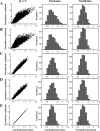Gravity outweighs the contribution of structure to passive ventilation-perfusion matching in the supine adult human lung
- PMID: 29051337
- PMCID: PMC5866448
- DOI: 10.1152/japplphysiol.00791.2016
Gravity outweighs the contribution of structure to passive ventilation-perfusion matching in the supine adult human lung
Abstract
Gravity and matched airway/vascular tree geometries are both hypothesized to be key contributors to ventilation-perfusion (V̇/Q̇) matching in the lung, but their relative contributions are challenging to quantify experimentally. We used a structure-based model to conduct an analysis of the relative contributions of tissue deformation (the "Slinky" effect), other gravitational mechanisms (weight of blood and gravitational gradient in tissue elastic recoil), and matched airway and arterial tree geometry to V̇/Q̇ matching and therefore to total lung oxygen exchange. Our results showed that the heterogeneity in V̇ and Q̇ were lowest and the correlation between V̇ and Q̇ was highest when the only mechanism for V̇/Q̇ matching was either tissue deformation or matched geometry. Heterogeneity in V̇ and Q̇ was highest and their correlation was poorest when all mechanisms were active (that is, at baseline). Eliminating the contribution of matched geometry did not change the correlation between V̇ and Q̇ at baseline. Despite the much larger heterogeneities in V̇ and Q̇ at baseline, the contribution of in-common (to V̇ and Q̇) gravitational mechanisms provided sufficient compensatory V̇/Q̇ matching to minimize the impact on oxygen transfer. In summary, this model predicts that during supine normal breathing under gravitational loading, passive V̇/Q̇ matching is predominantly determined by shared gravitationally induced tissue deformation, compliance distribution, and the effect of the hydrostatic pressure gradient on vessel and capillary size and blood pressures. Contribution from the matching airway and arterial tree geometries in this model is minor under normal gravity in the supine adult human lung. NEW & NOTEWORTHY We use a computational model to systematically analyze contributors to ventilation-perfusion matching in the lung. The model predicts that the multiple effects of gravity are the predominant mechanism in providing passive ventilation-perfusion matching in the supine adult human lung under normal gravitational loads, while geometric matching of airway and arterial trees plays a minor role.
Keywords: computational model; lung; ventilation-perfusion matching.
Figures




Similar articles
-
The gravitational distribution of ventilation-perfusion ratio is more uniform in prone than supine posture in the normal human lung.J Appl Physiol (1985). 2013 Aug 1;115(3):313-24. doi: 10.1152/japplphysiol.01531.2012. Epub 2013 Apr 25. J Appl Physiol (1985). 2013. PMID: 23620488 Free PMC article.
-
Lung ventilation and perfusion in prone and supine postures with reference to anesthetized and mechanically ventilated healthy volunteers.Anesthesiology. 2010 Mar;112(3):682-7. doi: 10.1097/ALN.0b013e3181cf40c8. Anesthesiology. 2010. PMID: 20179506
-
Spatial distribution of ventilation and perfusion: mechanisms and regulation.Compr Physiol. 2011 Jan;1(1):375-95. doi: 10.1002/cphy.c100002. Compr Physiol. 2011. PMID: 23737178 Review.
-
Contributions of pulmonary perfusion and ventilation to heterogeneity in V(A)/Q measured by PET.J Appl Physiol (1985). 1997 Apr;82(4):1163-76. doi: 10.1152/jappl.1997.82.4.1163. J Appl Physiol (1985). 1997. PMID: 9104853
-
Gas exchange under altered gravitational stress.Compr Physiol. 2011 Jan;1(1):339-55. doi: 10.1002/cphy.c090007. Compr Physiol. 2011. PMID: 23737176 Review.
Cited by
-
Simulating Multi-Scale Pulmonary Vascular Function by Coupling Computational Fluid Dynamics With an Anatomic Network Model.Front Netw Physiol. 2022 Apr 25;2:867551. doi: 10.3389/fnetp.2022.867551. eCollection 2022. Front Netw Physiol. 2022. PMID: 36926101 Free PMC article.
-
Prone positioning redistributes gravitational stress in the lung in normal conditions and in simulations of oedema.Exp Physiol. 2022 Jul;107(7):771-782. doi: 10.1113/EP089037. Epub 2021 Jan 6. Exp Physiol. 2022. PMID: 33347661 Free PMC article.
-
Ventilation/Perfusion Matching: Of Myths, Mice, and Men.Physiology (Bethesda). 2019 Nov 1;34(6):419-429. doi: 10.1152/physiol.00016.2019. Physiology (Bethesda). 2019. PMID: 31577170 Free PMC article. Review.
-
Patient-specific modeling of aerosol delivery in healthy and asthmatic adults.J Appl Physiol (1985). 2019 Dec 1;127(6):1720-1732. doi: 10.1152/japplphysiol.00221.2019. Epub 2019 Sep 12. J Appl Physiol (1985). 2019. PMID: 31513445 Free PMC article.
-
Towards a multi-scale computer modeling workflow for simulation of pulmonary ventilation in advanced COVID-19.Comput Biol Med. 2022 Jun;145:105513. doi: 10.1016/j.compbiomed.2022.105513. Epub 2022 Apr 12. Comput Biol Med. 2022. PMID: 35447459 Free PMC article.
References
-
- Altemeier WA, McKinney S, Glenny RW. Fractal nature of regional ventilation distribution. J Appl Physiol (1985) 88: 1551–1557, 2000. - PubMed
Publication types
MeSH terms
Grants and funding
LinkOut - more resources
Full Text Sources
Other Literature Sources

